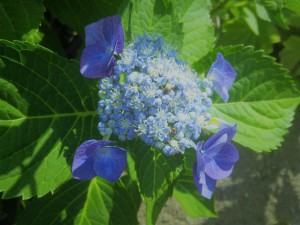
Normally, when I think of lace, my mind settles on images of brides and babies’ christening gowns. Artist James McNeil Whistler’s mother famously wore a lace-trimmed cap in his “Arrangement in Grey and Black No 1”, but she certainly did not look happy about it. At this time of the year, the lace that I see most often is on “lacecap” hydrangeas and it makes me joyful.
Lacecaps are varieties of bigleaf hydrangea or Hydrangea macrophylla. This deciduous species, which is also sometimes called “French hydrangea”, is actually native to Japan. Macrophyllas are most familiar in the form of the fabulous blue, pink or purple-flowered “mophead” hydrangeas that bloom abundantly—most years—in early summer. The mopheads feature big, globular flowerheads composed of scores of smaller, four-petaled florets. Reaching six to 10 feet tall and wide, the billowing shrubs bloom blue in acid soils, pink in alkaline media and purple when the soil is neutral.
Lacecaps, do the same color tricks according to soil chemistry, but tend to be smaller in stature and spread, and different in flower form. Instead of producing big, round balls of flowers, they sprout wide, flat-topped flowerheads. The “lace” is the area in the middle of the flower that is actually composed of scores of tiny true flowers. These are surrounded by a collar of larger, sterile florets that resemble those of the mophead hydrangeas. The effect is a little more subtle, but just as beautiful.
Both lacecaps and mopheads feature the same large, medium to dark green leaves that are shaped like toothed teardrops.
Authorities differ on lacecap commercial history. Denise Wyles Adams, in her wonderful book, Restoring American Gardens, 1640-1940, notes that the ‘Maculata’ or ‘Variegata’ varieties of variegated lacecap hydrangea were listed in the American Ellwanger & Barry catalog in 1860. Maggie Campbell-Culver, in her equally authoritative book, The Origin of Plants, asserts that English plant hunter, Charles Maries “discovered the first lacecaps” in Japan on a plant hunting expedition that began in 1877. Hydrangea ‘Mariesii’, named for Maries, was introduced commercially in 1879. Clearly no one told Maries that as he trekked through Japan in search of new plants, lacecaps were already on the market in the U.S. It is possible that the Ellwanger and Barry lacecaps were bred from “sports” or spontaneous genetic mutations occurring on standard mophead plants and the plants discovered by Maries were naturally occurring shrubs with similar origins.
Either way, lacecaps have been around for quite awhile, but have never been as popular as their showy relatives, the mopheads. This is changing, however. Not long ago, a friend, who is also an ace flower arranger, was touring a historic site and come upon a row of blue lacecaps blooming exquisitely. He had never seen them before and was completely smitten.
The tried-and-true ‘Mariesii’, with blue lacecaps is still on the market, but modern breeders have produced a number of other winning varieties. Among them is ‘Blue Wave’, with vibrant blue flowers and a compact, three and a half foot height and spread. ‘Lady in Red’ features dramatic dark red stems and pinkish to rose blooms. Its leaves turn scarlet in the fall, as do those of the flashy Twist and Shout™.
As with mophead hydrangeas, traditional lacecaps flower on “old wood”, which means that this year’s stems produce next year’s flowers. The problem with that trait is that the buds can be frozen by late spring frosts, resulting in a loss of summer blooms. Newer varieties, like Twist and Shout, bloom on “new wood” or stems produced in the year of bloom, which solves the spring frost problem. If you have experienced hydrangea disappointment when plants produce few or no flowers in any given year, it is worth seeking out the new varieties to fill holes in your planting scheme.
All big leaf hydrangeas prefer uniformly moist soil and light shade. Heavier shade will result in fewer blooms. Mulching is a good idea for both mopheads and lacecaps. Alternately, you can grow them in large containers, as long as you water regularly throughout the growing season and feed with commercial plant food according to manufacturer’s directions. If pesky spring frosts are a routine occurrence and you love your mature, traditional mophead and/or lacecap hydrangeas, you can wrap yours in comfy layers of burlap in the fall and remove it in spring when all danger of frost has passed. This doesn’t look particularly attractive, but may greatly improve the chance of abundant summer blooms.
If Whistler’s mother had been holding a bouquet of lacecap hydrangeas while her son memorialized her on canvas, she might have been considerably happier and the course of art history changed ever so slightly.
You probably can’t change art history, but you can improve your garden with lacecaps. Find a good selection at Hydrangeas Plus, PO Box 389, Aurora, OR 97002; 866-433-7896. www.hydrangeasplus.com.
